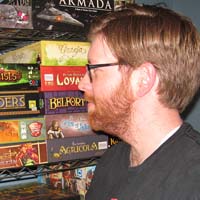Dungeon Fighter Review
on Jun 17, 2015
If you’re going to attack a gorgon, you should probably close your eyes. In Dungeon Fighter, you – the player- have to do exactly that. In this light hearted dexterity driven dungeon delve, players will chuck dice at a target while closing their eyes, jumping, or doing any number of other physical feats. The premise of the game is that the players have been shoved into a dungeon to prove their worth after the king has heard one too many unsubstantiated tales of bravery and glory. Once inside, the party moves from room to room in a randomized dungeon made up of three tiles. Each tile has two paths to get you to the end. Typically, one is an easy path with more rooms and one is a more difficult path with fewer rooms. Fewer rooms means fighting fewer monsters. At the end is the big boss who is hidden until the players get there.
Standard dungeoncrawl fare, but Dungeon Fighter is hardly standard for the genre. Sounds standard, right? Polyhedral dice rolled against numerical stats are out as resolution methods. Dungeon Fighter comes with a large cardboard target that becomes the playing surface. To attack, a player hurls dice at the target and the closer it lands to the bullseye, the more damage it does. Of course, players aren’t allowed to merely drop the die over the target. Instead, the die must bounce at least once on the table outside the target. Otherwise it’s a miss. The target also has a few holes cut into it. If your die falls in a hole, it’s also a miss.
As players progress through the dungeon, they fight bigger and meaner monsters. In the first few rooms, they might fight some creatures that have just a few points of health. But later on, maybe they fight something that takes five or six – and requires players to throw with their off hand. After that, you may encounter something that makes you throw with your eyes closed while jumping. Sometimes it’s even crazier like balancing the die off your nose or placing it in your neighbor’s hand and then trying to launch it. And a miss always results in the monster damaging the player.
The challenges get more and more difficult. But players can also buy magic items, weapons, and armor at the few shops sprinkled through the dungeon. Each player also has three special abilities that may trigger if the right face comes up on the die that they threw.
The weapons are fun. They are also something of a (pardon the phrase) double edged sword. Each says something like, “If you throw with your off hand and hit, then add one to the damage you did.†Or, “if you flick the die off your elbow and hit, then add two to the damage you did.†And so forth. In this way, players will be attempting all kinds of crazy shots even when not so required just in order to get the bonus damage.
Dungeon Fighter is crazy fun. But it’s important to understand what this game is not. It’s not a deep, thematic, campaign-driven dungeon crawl. The good news for those looking for those kinds of games is that there are plenty of other titles in an over-saturated market for that. But what it does provide is a unique experience, ensuring raucous laughter and an unparalleled good time. In each and every play of this game, you can expect hoots and hollers, howls of despair and incredible shouts of victory.
One of the great failings with dexterity games is that players eventually become practiced. The owner of the game, with more opportunities to play, simply becomes better in a way that makes the game uncompetitive and therefore potentially less fun for anyone else at the table. Dungeon Fighter addresses this issue nicely. First, it’s cooperative. So there is no direct competition and the skill should (hopefully) even out. Second, the weapons give added challenges to experienced players to ensure that they don’t get bored. But most importantly, the particular dexterity skill changes from encounter to encounter. As a result, even experienced players don’t get too much practice on any particular throw. This reduces the ability to really master the game and keeps it fresh and exciting for numerous plays.
As with any cooperative game, difficulty is also a factor. The game comes with different levels of monsters and you can stack the deck with greater or fewer easy ones to change the challenge. But, even at the easiest recommended difficulty, the game is hard - especially for new players. The dexterity skill utilized is not one you typically practice and it is ever so easy to over-shoot the target entirely and take damage. In fact, there have been numerous times where I’ve tried a few “practice throws†in advance and get some pretty good scores. I decide to throw “for real†and – boom! – right off the edge of the target. No damage on the monster and I lose life.
This isn’t just a dexterity game and there is more depth than you might expect. There are decisions to be made about which weapons or items to buy, when to use bonus dice, and even which route to go down when exploring the dungeon. Long term, strategic considerations can make the eventual fights more manageable. And, there’s always the discussion of who to give the weapons to. “Who hear is best at balancing a die on their nose?†“Who can throw with their eyes below the table surface?â€
Dungeon Fighter is great. Win or lose, you’ll laugh at and with your fellow players the whole time.

 Customer Support
Customer Support  Subscribe
Subscribe 




 Account
Account  Wishlist
Wishlist 
